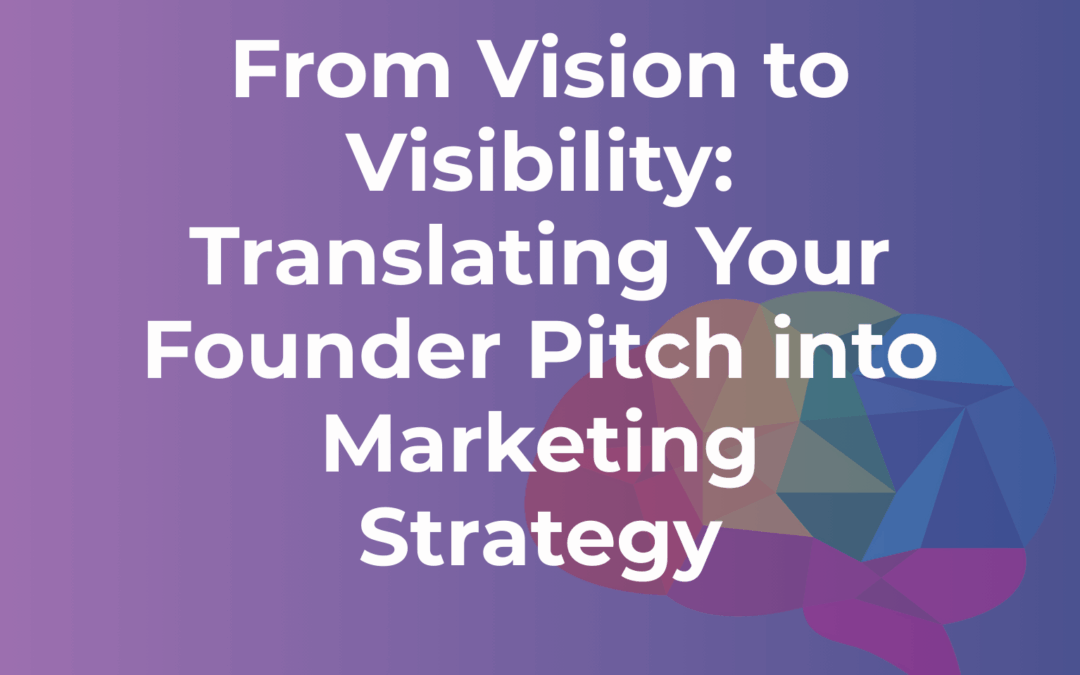You’ve pitched it to investors, advisors, maybe even a few early customers. You’ve got your why, your edge, and your vision down cold.
But here’s the catch:
Just because your pitch is clear doesn’t mean your marketing is.
What works in a pitch deck — high-level, fast-paced, investor-focused — doesn’t always work when you’re trying to connect with customers. Turning that sharp founder pitch into consistent, usable marketing is one of the most important (and most overlooked) steps in early-stage growth.
This post breaks down how to translate your founder story into a real, usable founder messaging strategy — one that can power your content, campaigns, and customer acquisition.
Let’s go!
Your Founder Pitch = Raw Messaging Gold
Most early-stage startups already have the raw ingredients of great messaging — they’re just buried in the pitch deck.
Think about what’s already there:
- The problem you’re solving
- Who you’re solving it for
- What makes your approach different
- Why your solution matters now
That’s not just fundraising material. That’s the core of your message.
But it has to be translated — from “investor-friendly” to “customer-ready.”
The pitch tells people what you do.
Your messaging tells people why it matters to them — and why they should take action.
How to Break Down Your Pitch Into Marketing Assets
Let’s turn your vision into visibility — one piece at a time.
1. Clarify Your Value Proposition
Start here. This is the heart of your messaging.
Your value proposition should answer:
- Who you help
- What you help them do
- Why they should choose you
Pitch version: “We automate invoice reconciliation for mid-market hotels.”
Marketing version: “Stop chasing down invoices. Our platform helps hotel finance teams close the books in hours — not days.”
Make it about them. Not about you.
2. Define Your Messaging Pillars
Your pitch likely hits on a few themes. These should become the backbone of your marketing content.
Examples:
- Speed or simplicity
- Time savings or efficiency
- Transparency
- Industry expertise
- Personalization
Choose 2–3 of these and commit to them. They’ll shape your tone, your copy, your campaign strategy, and how people remember you.
Repetition builds clarity.
3. Find and Use Customer Language
This is where most early-stage messaging falls short.
If your pitch is full of buzzwords and acronyms — or sounds like something you’d say to investors — it’s probably not connecting with your audience.
To fix that, look for real-world language from:
- Sales calls and demo feedback
- Support tickets or live chat
- Onboarding surveys or user interviews
- Testimonials or early reviews
Find the exact phrases people use to describe their problem, your product, and their outcomes. Then reflect those back in your marketing.
Founder pitch: “We use AI to streamline multi-system purchasing.”
Customer message: “It pulls everything into one place so I don’t have to check five platforms.”
Which one sounds more like marketing? Exactly.
From Message to Strategy
Once your messaging is clear, it’s time to make it visible. And that means connecting it to strategy — not just copy.
Here’s where your founder messaging strategy should show up:
- Website copy
- Headline: Does it clearly explain what you do and for who?
- Subcopy: Does it connect emotionally and logically?
- Email campaigns
- Does each sequence reinforce your core value prop or one of your messaging pillars?
- Social posts
- Are you showing up with consistent themes, tone, and POV?
- Sales enablement
- Do your one-pagers, pitch decks, and demo scripts match what’s on your homepage?
Messaging isn’t one document or one brainstorm. It’s the thread that connects every part of your go-to-market strategy.
Where Founders Get Stuck
Let’s save you some pain. Here’s where messaging tends to break down:
- Using investor language in customer-facing channels
- Constantly changing the message based on random feedback
- Over-indexing on product features, under-indexing on customer benefits
- Treating marketing as a handoff — not an extension of the founder’s clarity
You don’t need to rewrite your story. You just need to reframe it for the people you’re trying to reach.
Final Thoughts: Your Message Is the Strategy
You already have the story. You just need to shape it for your audience.
When you take the clarity from your founder pitch and turn it into consistent, scalable messaging, you unlock your next phase of growth. You go from selling an idea to selling a solution people actually understand, remember, and want.
So if you’re struggling to connect, convert, or explain what you do?
It’s not your product. It’s your message.
And when you’re ready to sharpen it?
Mathlete Marketing can help.
Further Resources: Founder Messaging + Positioning
Looking to take your messaging even further? These are go-to guides for founders building smart, scalable brand strategy from day one:
- 🔹 "Sales P!tch" by April Dunford A new book showing a systematic way to build a sales pitch that wins.
- 🔹 Strategyzer – Value Proposition Canvas A visual tool to clarify who you're serving and why your product matters. Perfect for early messaging alignment.
- 🔹 BCV - "How To Tell Your Startup’s Story in a Memorable Way " Real-world advice for founders on how to translate your vision into messaging that resonates.
- 🔹 HubSpot - 12 Startup Pitch Deck Examples Twelve pitch deck examples for startups, plus a pitch deck template.

